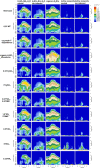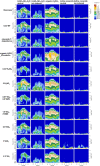Global variability in atmospheric new particle formation mechanisms
- PMID: 38867037
- PMCID: PMC11222162
- DOI: 10.1038/s41586-024-07547-1
Global variability in atmospheric new particle formation mechanisms
Abstract
A key challenge in aerosol pollution studies and climate change assessment is to understand how atmospheric aerosol particles are initially formed1,2. Although new particle formation (NPF) mechanisms have been described at specific sites3-6, in most regions, such mechanisms remain uncertain to a large extent because of the limited ability of atmospheric models to simulate critical NPF processes1,7. Here we synthesize molecular-level experiments to develop comprehensive representations of 11 NPF mechanisms and the complex chemical transformation of precursor gases in a fully coupled global climate model. Combined simulations and observations show that the dominant NPF mechanisms are distinct worldwide and vary with region and altitude. Previously neglected or underrepresented mechanisms involving organics, amines, iodine oxoacids and HNO3 probably dominate NPF in most regions with high concentrations of aerosols or large aerosol radiative forcing; such regions include oceanic and human-polluted continental boundary layers, as well as the upper troposphere over rainforests and Asian monsoon regions. These underrepresented mechanisms also play notable roles in other areas, such as the upper troposphere of the Pacific and Atlantic oceans. Accordingly, NPF accounts for different fractions (10-80%) of the nuclei on which cloud forms at 0.5% supersaturation over various regions in the lower troposphere. The comprehensive simulation of global NPF mechanisms can help improve estimation and source attribution of the climate effects of aerosols.
© 2024. The Author(s).
Conflict of interest statement
The authors declare no competing interests.
Figures















References
-
- Lee S-H, et al. New particle formation in the atmosphere: from molecular clusters to global climate. J. Geophys. Res. Atmos. 2019;124:7098–7146.
-
- Kulmala M, et al. Is reducing new particle formation a plausible solution to mitigate particulate air pollution in Beijing and other Chinese megacities? Faraday Discuss. 2021;226:334–347. - PubMed
-
- Yao L, et al. Atmospheric new particle formation from sulfuric acid and amines in a Chinese megacity. Science. 2018;361:278–281. - PubMed
-
- Cai R, et al. Sulfuric acid-amine nucleation in urban Beijing. Atmos. Chem. Phys. 2021;21:2457–2468.
LinkOut - more resources
Full Text Sources

